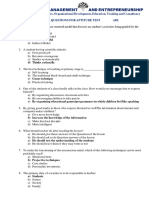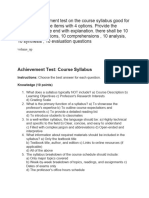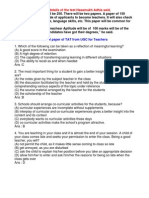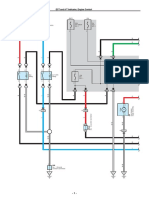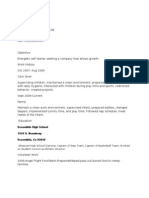12-100 Mcqs On General Method of Teaching PDF For All Screening Tests
12-100 Mcqs On General Method of Teaching PDF For All Screening Tests
Uploaded by
dagnaw megbaruCopyright:
Available Formats
12-100 Mcqs On General Method of Teaching PDF For All Screening Tests
12-100 Mcqs On General Method of Teaching PDF For All Screening Tests
Uploaded by
dagnaw megbaruOriginal Title
Copyright
Available Formats
Share this document
Did you find this document useful?
Is this content inappropriate?
Copyright:
Available Formats
12-100 Mcqs On General Method of Teaching PDF For All Screening Tests
12-100 Mcqs On General Method of Teaching PDF For All Screening Tests
Uploaded by
dagnaw megbaruCopyright:
Available Formats
PDF NOTES
WWW.PAKISTANBIX.COM
Pakistanbix.com is an online test preparation website where aspirants can prepare themselves for
all types of entry tests. Users can prepare themselves for CCS, PMS, PPSC, FPSC, BPSC, SPSC,
KPPSC, AJKPSC, NTS, PTS, Headmaster, Lecturer, SST and types of exams. Here users can see
all subjects Mcqs, Daily Current Affairs, Daily Dawn Vocabulary, Online tests/Quiz, Past Papers,
PDF Notes of All Subjects and allothers valueable Data.
All subjects PDF notes are posted here in this section. Users can read all the pdf notes
online or they have choice to download these notes in the the form of Pdf. General
knowledge, Pakistan Affairs, Islamic Studies, English, Everyday Science, Urdu, Maths,
Current Affairs, Pedagogy, Biology, Chemistry, Physics and all subjects pdf notes are
available here. Aspirants of CSS, PMS, FPSC, PPSC, AJKPSC, KPPSC, BPSC, SPSC,
NTS, PTS, OTS, Lecturer, Headmaster, Educators etc can download all material in pdf
form from here.
Follow our facebook page for more data: https://web.facebook.com/pakbixx
For All subjects PDF: https://www.pakistanbix.com/category/notes/
General Knowledge PDF: https://www.pakistanbix.com/category/notes/general-knowledge-pdf/
Pak Study PDF: https://www.pakistanbix.com/category/notes/pak-study-pdf/
Islamyat PDF: https://www.pakistanbix.com/category/notes/islamiyat-pdf/
English PDF: https://www.pakistanbix.com/category/notes/english-pdf/
Physics PDF: https://www.pakistanbix.com/category/notes/physics/
Chemistry PDF: https://www.pakistanbix.com/category/notes/chemistry-pdf/
Biology PDF: https://www.pakistanbix.com/category/notes/biology/
Computer Knowledge PDF: https://www.pakistanbix.com/category/notes/basic-computer-pdf/
Pedagogy/Education PDF: https://www.pakistanbix.com/category/notes/pedagogy-pdf/
GENERAL METHODS OF TEACHING SOLVED MCQs
1. In teaching experienced members guide the immature one’s for
(a) Spending time
(b) Qualification
(c) Quality of life
(d) Adjustment of life
Answer is = d
2. Which is not the focal point of triangular process of teaching
(a) Teaching method
(b) Teacher
(c) Pupil
(d) contents
Answer is = a
3. The goal of teaching is
(a) to give information
(b) To involve pupils in activities
(c) To impart knowledge
(d) Desirable change in behavior
Answer is = d
4. The rules of presenting the contents to make them easy are called
(a) Method of teaching
(b) Maxims of teaching
(c) Techniques of teaching
(d) Teaching strategies
Answer is = b
5. SOLO stands for
(a) System of the observed learning outcome
(b) structure of the observed learingn output
(c) Structure of the observed learning outcome
(d) System of the observed learning output
Answer is = c
6. SOLO taxonomy consists of levels
(a) 2
(b) 3
(c) 4
(d) 5
Answer is = c
7. With reference to solo taxonomy one aspect of a task is understood in
(a) Unistructural level
(b) Multistructural level
(c)Rational level
(d) Extended abstract level
Answer is = a
8. Two or more aspects are understood in
(a) Unistructural lever
(b) Multistructural level
(c)Rational level
(d) Extended abstract level
Answer is = b
9. Integration is developed between two or more Aspects in
(a) Unistructural level
(b) Multistructural level
(c)Rational level
(d) Extended abstract level
Answer is = c
10. To go beyond the given in formation is
(a) Unistructural level
(b) Multistructural level
(c)Rational level
(d) Extended abstract level
Answer is = d
11. SOLO taxonomy was presented by
(a) Bloom
(b) Krath whol
(c)Simpson
(d) Biggs & collis
Answer is = d
12. Students are passive in
(a) Project method
(b) Discovery method
(c)Lecture method
(d) Inquiry method
Answer is = c
13. Symposium is a type of
(a) Discovery method
(b) Discussion method
(c)Lecture method
(d) Demonstration method
Answer is = b
14. Heuristic means
(a) To investigate
(b) To show
(c)To do
(d) To act
Answer is = a
15. Arm strong was the exponent of
(a) Problem solving method
(b) Project method
(c)Discussion method
(d) Heuristic method
Answer is = d
16. According to Kilpatrick, the types of projects are
(a) 2
(b) 3
(c)5
(d) 5
Answer is = c
17. Activity involves
(a) Physical action
(b) Mental action
(c)Mental action
(d) Physical and mental action
Answer is = d
18. We move from specific to general in
(a) Inductive method
(b) Deductive method
(c)Drill method
(d) Discussion method
Answer is = a
19. Practice is made in
(a) Inductive method
(b) Deductive method
(c)Drill method
(d) Discussion method
Answer is = c
20. The Socratic method is known as
(a) Lecture demonstration method
(b) Discussion method
(c)Inquiry method
(d) Question- Answer method
Answer is = d
21. Which is not true about projects
(a) It is a purposeful activity
(b) It is proceeded in social environment
(c)It is accomplished in real life
(d) It is teacher centred activity
Answer is = d
22. Duration of lessons in macro- lesson plans is
(a) 5-10 min
(b) 10-20 min
(c)20-30 min
(d) 35-45 min
Answer is = d
23. In British approach of lesson planning, more emphasis is on
(a) Activity
(b) Teacher
(c)Content presentation
(d) Teacher and content presentation
Answer is = d
24. American approach emphasizes
(a) Teacher
(b) Content presentation
(c)Learning objectives
(d) Methods
Answer is = c
25. Which one is not the type of lesson plans on the basis of objectives
(a) Micro lesson plan
(b) Cognitive lesson plan
(c)Affective lesson plan
(d) Psychomotor lesson paln
Answer is = a
26. Which is not true about lesson plan
(a) It is develops confidence
(b) It helps in oderly delivny of contents
(c)It is developed by students
(d) It saves from haphazard teaching
Answer is = c
27. A good drama does not include
(a) Interesting story
(b) Alive dialogues
(c)Very long play
(d) Subject full of feelings
Answer is = c
28. Which is not the objective of Drama/ role play
(a) Recreation and enjoyment
(b) Development of social skills
(c)Development of skills of conversation
(d) Do make rehearsals
Answer is = d
29. Drama or role play is useful for teaching
(a) History
(b) Science
(c)Malts
(d) Language
Answer is = a
30. The main types of teleconferencing identified are
(a) 2
(b) 3
(c) 4
(d) 5
Answer is = b
31. Which is not the types of teleconferencing
(a) Audio teleconferencing
(b) Video teleconferencing
(c)T.V teleconferencing
(d) Computer teleconferencing
Answer is = c
32. Which one is accountable in cooperative learning
(a) Individual
(b)Group
(c) Both a & b
(d) None of a & b
Answer is = c
33. Cooperative learning is an alternative to
(a) competitive models
(b) Teaching models
(c)lesson plans
(d)Micro teaching
Answer is = a
34. The number of students in cooperative learning groups are
(a) 3-4
(b) 5-6
(c) 8-10
(d) 10-15
Answer is = a
35. The essential characteristic of cooperative learning is
(a) Effective learning
(b)Positive interdependence
(c)Cooperation
(d) Division of labour
Answer is = b
36. The students like to spend the most of the time with
(a) Teachers
(b) parents
(c) Relatives
(d) Peers
Answer is = d
37. Peer culture constitutes
(a) Socialization
(b) Individualization
(c) Both a & b
(d) None of a & b
Answer is = a
38. Which is not the advantage of team teaching
(a) Better utilization of resources
(b) Better planning
(c) Better use of teaching techniques
(d) Better financial benefits of teachers
Answer is = d
39. The hypothesis underlying team teaching is
(a) Teachers feel bore while working alone
(b) Teachers are not competent
(c) The best teachers in schools are shared by more students
(d) The single teacher cannot control the class
Answer is = c
\
40. CAI stands for
(a) Computer analyzed instruction
(b) Computer assisted instruction
(c) Computer assisted interview
(d) Computer analyzed interview
Answer is = b
41. Which is not the mode of CAI
(a) Tutorial mode
(b) Drill mode
(c) Simulation mode
(d) Question mode
Answer is = d
42. Example of psychomotor domain is that student
(a) Demonstrates awareness to environmental pollution
(b) Performs an experiment
(c) Can computer results of two experiments
(d) Can narrate a story
Answer is = b
43. Ability to develop a life style based upon the preferred value system is
(a) Responding
(b) Valuing
(c) Organizing
(d) Characterizing
Answer is = d
44. Example of cognitive domain is
(a)Describe a topic
(b) Develop an X-ray film
(c) Type a letter
(d) Take responsibility for tools
Answer is = a
45. At the highest level of hierarchy is
(a) Understanding
(b) Application
(c) Evaluation
(d) Analysis
Answer is = c
46. Student can design a laboratory according to certain specification in
which category of objective?
(a) Analysis
(b) Synthesis
(c) Evaluation
(d) Knowledge
Answer is = b
47. The number of domains in taxonomies of educational objective is
(a) Tow
(b) Three
(c) Five
(d) Six
Answer is = b
48. The highest level of cognitive domain is
(a) Synthesis
(b) Analysis
(c) Comprehension
(d) Evaluation
Answer is = d
49. The process of determing the value or worth of anything is
(a) Test
(b) Measurement
(c) Assessment
(d) Evaluation
Answer is = d
50. Educational objectives have been divide into
(a) Two domains
(b) Three domains
(c) Four domains
(d) Five domains
Answer is = b
51. Taxonomy of educational objectives was presented in
(a) 1946
(b) 1956
(c) 1966
(d) 1976
Answer is = b
52. The classification of cognitive domain was presented by
(a) Benjamin S. Bloom
(b) Skinner
(c) Krathwhol
(d) Simpson
Answer is = a
53. Cognitive domain have
(a) Three subgroups
(b) Four subgroups
(c) Five subgroups
(d) Six subgroups
Answer is = d
54. The lowest level of learning in cognitive domain is
(a) Comprehension
(b) Application
(c) Knowledge
(d) Synthesis
Answer is = c
55. The highest level of learning in cognitive domain is
(a) Evaluation
(b) Synthesis
(c) analysis
(d) Application
Answer is = a
56. The right sequence of subgroups cognitive domain is
(a) Knowledge, Comprehension, Application, Synthesis, analysis,
Evaluation
(b) Knowledge, Comprehension, application, Evaluation, analysis,
Synthesis
(c) Knowledge, Comprehension, Evaluation, application, Analysis, Syntesis
(d) Knowledge, Comprehension, application, analysis, Synthesis Evaluation
Answer is = d
57. Knowing/ memorizing and recalling is concerned with
(a) Cpmprehension
(b) Application
(c) Knowledge
(d) Evaluation
Answer is = c
58. To grasp the meaning of the material is
(a) Comprehension
(b) Applicatin
(c) Knowledge
(d) Synthysis
Answer is = a
59. To use previous learned material in new situation is
(a) Comprehension
(b) Application
(c) Knowledge
(d) analysis
Answer is = b
60. To break down material into component parts to know its organizational
structure is
(a) Comprehension
(b) application
(c) Analysis
(d) Synthesis
Answer is = c
61. To put ideas together to form a new whole is
(a) Evaluation
(b) Synthesis
(c) Analysis
(d) Application
Answer is = b
62. To know the worth or value of material is
(a) Analysis
(b) Application
(c) Knowledge
(d) Evaluation
Answer is = d
63. The intellectual skills are reflected by
(a) Cognitive Domain
(b) affective domain
(c) Psychomotor
(d) None of above
Answer is = a
64. Attitudes, values and interests are reflected by
(a) Cognitive Domain
(b) Affective Domain
(c) Psychomotor Domain
(d) None of above
Answer is = b
65. Which domain is concerned with physical and motor skills?
(a) Cognitive Domain
(b) Affective Domain
(c) Psychomotor domain
(d) None of above
Answer is = c
66. The focus of cognitive domain is
(a) Physical and Motor skills
(b) Intellectual Skills
(c) Attitudes and Interests
(d) None of above
Answer is = b
67. The affective domain was classified by
(a) Benjamin S. Bloom
(b) Simpson
(c) Krathwhol
(d) Burner
Answer is =c
68. Affective domain is divided into
(a) four subgroups
(b) Five subgroups
(c) Six subgroups
(d) seven subgroups
Answer is = b
69. The lowest level of learning in affective domain is
(a) Responding
(b) Valuing
(c) Attending
(d) Organization
Answer is = c
70. Which is placed at the highest level of learning in affective domain
(a) Attending
(b) Responding
(c) Organization
(d) Characterization
Answer is = d
71. Right order of sub- groups of affective domain is
(a) Attending, Responding, Valuing, characterization, Organization
(b) attending, Responding, Characterization, Valuing, Organization
(c) Attending, Valuing, Responding, Organization, Characterization
(d) Attending, Responding, Valuing, Organization, Characterization
Answer is = d
72. Willingness to attend to particular phenomenon is
(a) Attending/ Receiving
(b) Responding
(c) Valuing
(d) Organization
Answer is = a
73. Which sub- group of affective domain focuses on active participation in
(a)Attending/ Receiving
(b) Responding
(c) Valuing
(d) Organization
Answer is = b
74. Bringing together different values into a comsistent value system is
(a) Attending/ Receiving
(b) Responding
(c) Valuing
(d) Organization
Answer is = d
75. Affective domain focuses on adoption of a value system as a part of life
style in
(a) Responding
(b) Valuing
(c) Organization
(d) Characterization
Answer is = d
76. Psychomotor domain was classified by Simpson in
(a) 1962
(b) 1972
(c) 1982
(d) 1992
Answer is = b
77. Affective domain was divided into subgroups by Krathwhol in
(a) 1954
(b) 1964
(c) 1974
(d) 1984
Answer is = b
78. Psychomotor domain was divided by Simpson in
(a) Four subgroups
(b) Five subgroups
(c) Six subgroups
(d) Seven subgroups
Answer is = d
79. The Characteristic of behavioral objective is
(a) Observable and Immeasurable
(b) Non- observable
(c) Observable and measurable
(d) None of above
Answer is = c
80. The right sequence of sub-groups of psychomotor domain is
(a) Perception, Set, Guided response, Mechanism, Complex overt
response, adaptation, Origination
(b) Perception, Complex over response, Set, Guided, response,
Mechanism, adaptation, Organization
(c) Set, Origination, Guided response, Mechanism Complex overt
response, Adaptation, perception
(d) Guided response, Mechanism, perception, Set, Adaptation,
Organization, Complex overt response
Answer is = a
81. Objective related to affective domain is
(a) Student can paint a picture
(b) Student can draw a graph
(c) Student values honesty
(d) Student can write a letter
Answer is = c
82. Bring together scientific ideas to form a unique idea is
(a) Application
(b) analysis
(c) Synthesis
(d) Evaluation
Answer is = c
83. Which is vast in scope
(a) Teaching tactic
(b) Teaching Technique
(c) Teaching Strategy
(d) Teaching Method
Answer is = c
84. Students find/explore the in formations themselves in
(a) lecture method
(b) Discovery method
(c) Both
(d) none
Answer is = b
85. Teacher performs practically and explains in
(a) Lecture method
(b) discovery method
(c) demonstration method
(d) Problem solving method
Answer is = c
86. Role of student is active in
(a) Discover method
(b) Problem solved method
(c) Inquiry method
(d) All above
Answer is = d
87. Micro teacher is a
(a) Teacher method
(b) Teaching training technique
(c) Motivational technique
(d) none of above
Answer is = b
88. What is the tie of presentation in Micro teaching?
(a) 1-5 min
(b) 5-10 min
(c) 10-15 min
(d) 15-20 min
Answer is = b
89. What is the No of students in micro teaching?
(a) 1-5
(b) 5-10
(c) 10-15
(d) 15-20
Answer is = b
90. Micro teaching started in
(a) 1950
(b) 1960
(c) 1970
(d) 1980
Answer is = b
91 Micro teaching focuses on the competency over
(a) Method
(b) Skills
(c) Contents
(d) None of above
Answer is = b
92. Which is more suitable in teaching of science?
(a) Lecture method
(b) demonstration method
(c) Discussion method
(d) Project method
Answer is = d
93. Which one is exception?
(a) Books
(b) Magazine
(c) Diagrams
(d) T.V
Answer is = d
94. Which is not included in print media?
(a) Books
(b) Magazine
(c) Diagrams
(d) T.V
Answer is = d
95. How many senses a person uses while observing film?
(a) 1
(b) 2
(c) 3
(d) 4
Answer is = b
96. How much knowledge is gained through the sense of seeing?
(a) 75%
(b) 13%
(c) 6%
(d) 3%
Answer is = a
97. How much knowledge is gained through the sense of listening?
(a)75%
(b) 13%
(c) 6%
(d) 3%
Answer is = b
98. How much knowledge is gained through the sense of touch?
(a)75%
(b) 13%
(c) 6%
(d) 3%
Answer is = c
99. How much knowledge is gained through the sense of smell?
(a) 75%
(b) 13%
(c)6%
(d) 3%
Answer is = d
100. How much knowledge is gained through the sense of taste?
(a)75%
(b) 13%
(c) 6%
(d) 3%
Answer is = d
Useful links for the the preparation of Tests
GK Mcqs: https://www.pakistanbix.com/category/general-knowledge-mcqs/
Pak Study Mcqs: https://www.pakistanbix.com/category/pak-studies-mcqs/
Islamyat Mcqs: https://www.pakistanbix.com/category/islamic-studies-mcqs/
Current Affairs Mcqs: https://www.pakistanbix.com/category/current-affairs-mcqs/
English Mcqs: https://www.pakistanbix.com/category/english-mcqs/
English Literature Mcqs: https://www.pakistanbix.com/category/english-literature-mcqs/
Everyday Science Mcqs: https://www.pakistanbix.com/category/everyday-science-mcqs/
Physics Mcqs: https://www.pakistanbix.com/category/physics-mcqs/
Chemistry Mcqs: https://www.pakistanbix.com/category/chemistry-mcqs/
Biology Mcqs: https://www.pakistanbix.com/category/biology-mcqs/
Computer Knowledge Mcqs: https://www.pakistanbix.com/category/basic-computer-mcqs/
MS Office Mcqs: https://www.pakistanbix.com/category/ms-office-mcqs/
Pedagogy Mcqs: https://www.pakistanbix.com/category/pedagogy-mcqs/
You might also like
- Teaching Aptitude Questions and AnswersDocument20 pagesTeaching Aptitude Questions and AnswersAtif Rehman84% (38)
- Scaff Wind CalcsDocument1 pageScaff Wind CalcsHari HaranNo ratings yet
- Tnset Paper 1 Teaching Aptitude All Net Exam Questions With AnswersDocument11 pagesTnset Paper 1 Teaching Aptitude All Net Exam Questions With Answersvijai95% (20)
- Pedagogy MCQs Preparation For NTS Entry Tests and EducatorDocument8 pagesPedagogy MCQs Preparation For NTS Entry Tests and EducatorABDUL RAUF100% (3)
- Teaching AptitudeDocument21 pagesTeaching AptitudeGarima Sidher100% (1)
- 2.teaching Aptitude - Questions With AnswersDocument21 pages2.teaching Aptitude - Questions With AnswersSAFA's Creation100% (3)
- MCQs CurriculumDocument17 pagesMCQs CurriculumAhsan Ul Haq100% (18)
- Pedagogy MCQs PDF BookDocument91 pagesPedagogy MCQs PDF BookWasim khan100% (4)
- Head Master & Mastress Notes 1 PDFDocument12 pagesHead Master & Mastress Notes 1 PDFanila hamzaNo ratings yet
- General Methods of TeachingDocument21 pagesGeneral Methods of TeachingAdnan ArshadNo ratings yet
- Set-01 (Teaching-Methods)Document35 pagesSet-01 (Teaching-Methods)Hafiz muhammad zeshanNo ratings yet
- EST 104 MR TaiwoDocument26 pagesEST 104 MR Taiwodavystones441No ratings yet
- General Methods of Teaching Mcqs With Solved AnswersDocument24 pagesGeneral Methods of Teaching Mcqs With Solved AnswersAurangzeb Abbasi100% (1)
- HM McqsDocument97 pagesHM McqsAttaullahNo ratings yet
- 125 MCQS With Solutions for Core PedagogyDocument19 pages125 MCQS With Solutions for Core PedagogybeddetailingNo ratings yet
- Teaching Techniques and Methodology Past Paper MCQS For FPSC, PPSC, KPPSC, SPSC and NTS EtcDocument20 pagesTeaching Techniques and Methodology Past Paper MCQS For FPSC, PPSC, KPPSC, SPSC and NTS EtcMadiha Memosh80% (15)
- You Have A Mixed Class of Boys and Girls. Which Method Would You Adopt To Improve CoDocument3 pagesYou Have A Mixed Class of Boys and Girls. Which Method Would You Adopt To Improve CoMahmood Akhtar KhanNo ratings yet
- SPSC FPSC BPSC Headmaster Sample Model MCQs Past Papers Important Questions - Download PPSC FPSC NTS PTS UTS OTS ITS Solved MCQs Past Papers2017,2Document19 pagesSPSC FPSC BPSC Headmaster Sample Model MCQs Past Papers Important Questions - Download PPSC FPSC NTS PTS UTS OTS ITS Solved MCQs Past Papers2017,2Akram100% (2)
- Paper 1 Practise Book PDFDocument110 pagesPaper 1 Practise Book PDFsawmya shanmuganathanNo ratings yet
- 2nd TestDocument3 pages2nd TestMahmood Akhtar KhanNo ratings yet
- Teaching AptitudeDocument7 pagesTeaching AptitudesankulsybcaNo ratings yet
- General Methods of TeachingDocument3 pagesGeneral Methods of Teachingfarwa mughalNo ratings yet
- Curriculum DeveDocument8 pagesCurriculum Devebeejaydrums12No ratings yet
- Teaching Techniques and Methodology McqsDocument24 pagesTeaching Techniques and Methodology McqsRizwan AliNo ratings yet
- ADI Trial Questions and AnswersDocument26 pagesADI Trial Questions and AnswersSir BoBBYNo ratings yet
- Workshop Aptitude Test On Supervisory JudgementDocument48 pagesWorkshop Aptitude Test On Supervisory JudgementEbenezer Kofi TsiadaNo ratings yet
- JAPOS - March 9 Write An Achievement Test On The Course Syllabus Good For 50 Multiple Choice Items With 4 OptionsDocument6 pagesJAPOS - March 9 Write An Achievement Test On The Course Syllabus Good For 50 Multiple Choice Items With 4 Optionslorie anne todocNo ratings yet
- DD Questions and AnswersDocument25 pagesDD Questions and AnswersO. K. E RUSHESNo ratings yet
- Curriculum - July 2024Document5 pagesCurriculum - July 2024chrishmahansaneeNo ratings yet
- CTET EXAM PSYCHOLOGY Model Questions - Teacher Education For YouDocument10 pagesCTET EXAM PSYCHOLOGY Model Questions - Teacher Education For Youmukesh kumarNo ratings yet
- Teaching Aptitude Most Important Questions With Answers Part 1Document4 pagesTeaching Aptitude Most Important Questions With Answers Part 1Venkatesan RNo ratings yet
- Ugc Net Paper I 13 Years 6000mcq ComboDocument1,651 pagesUgc Net Paper I 13 Years 6000mcq ComboAnjali GargNo ratings yet
- Pedagogy Mcqs or Mcqs On EducationDocument16 pagesPedagogy Mcqs or Mcqs On EducationMir Pasand Baloch83% (6)
- ADI trial questions and answersDocument29 pagesADI trial questions and answerspatriciaacquah30oNo ratings yet
- Set 05 (Teaching Methods) 095820Document46 pagesSet 05 (Teaching Methods) 095820Bushra ZafarNo ratings yet
- MCQ - Teaching Aptitude - Solved PaperDocument8 pagesMCQ - Teaching Aptitude - Solved PaperSine Summsun PradhanNo ratings yet
- Soalan Sce 3108Document8 pagesSoalan Sce 3108Devi Govindasamy100% (1)
- ELT McqsDocument31 pagesELT McqsLasani75% (4)
- Pedagogy MCQS: (A) Man-Power Approach (B)Document29 pagesPedagogy MCQS: (A) Man-Power Approach (B)MUHAMMAD TAUFEEQNo ratings yet
- UGC Teaching AptitudeDocument25 pagesUGC Teaching AptitudeRohit SahuNo ratings yet
- Is Not A Level of Teaching LearningDocument19 pagesIs Not A Level of Teaching LearningJamil Khan100% (1)
- Model Paper of TAT From UGC For Teachers: Giving Details of The Test Hasamukh Adhia SaidDocument22 pagesModel Paper of TAT From UGC For Teachers: Giving Details of The Test Hasamukh Adhia Saidshailesh5180No ratings yet
- Essential SkillsDocument48 pagesEssential SkillssulemanasurajuNo ratings yet
- TestbankDocument100 pagesTestbankHazel AcostaNo ratings yet
- 15 Mcq's of Education (5 Files Merged)Document14 pages15 Mcq's of Education (5 Files Merged)Kashif IftikharNo ratings yet
- 8626 Solved QuizDocument58 pages8626 Solved Quizmk4597246No ratings yet
- TestDocument25 pagesTestHashim Zameer SanghiNo ratings yet
- Facilitating Learning ExamDocument18 pagesFacilitating Learning Examjosalyncastillo1No ratings yet
- The Teacher and The School CurriculumDocument9 pagesThe Teacher and The School CurriculumCarlo Petallar BuladacoNo ratings yet
- Question Paper 1 NHTET April 2017Document16 pagesQuestion Paper 1 NHTET April 2017peeyushbcihmct100% (1)
- Prof-Ed 2021Document9 pagesProf-Ed 2021Moznalyn KamlaniNo ratings yet
- Curriculum Development ExaminationDocument16 pagesCurriculum Development Examinationjosalyncastillo1No ratings yet
- EDU433 Final Term 15 Paper by Everblue 18february2024Document46 pagesEDU433 Final Term 15 Paper by Everblue 18february2024sanam.khang.bzuNo ratings yet
- Teaching AptitudeDocument49 pagesTeaching AptitudeganguluriNo ratings yet
- Ekon Special Mock Examination - General Profesional KnowledgeDocument20 pagesEkon Special Mock Examination - General Profesional KnowledgemelchilordNo ratings yet
- Edu431 Final MCQDocument23 pagesEdu431 Final MCQAsif Fareed100% (2)
- Achieving your Award in Education and Training: The Comprehensive Course Companion (Special Edition)From EverandAchieving your Award in Education and Training: The Comprehensive Course Companion (Special Edition)No ratings yet
- Achieving your Award in Education and Training: The Comprehensive Course CompanionFrom EverandAchieving your Award in Education and Training: The Comprehensive Course CompanionNo ratings yet
- Learning Assessment Techniques: A Handbook for College FacultyFrom EverandLearning Assessment Techniques: A Handbook for College FacultyNo ratings yet
- Analysis of Displacement of A Concrete Barrier OnDocument9 pagesAnalysis of Displacement of A Concrete Barrier OnDyah Nimas Ayu SekartiNo ratings yet
- EXW P006 0000 CS SHC MT 00096 Method Statement For Landscaping Rev.0Document28 pagesEXW P006 0000 CS SHC MT 00096 Method Statement For Landscaping Rev.0Syed Umair HashmiNo ratings yet
- The Surgical Anatomy of The Pulmonary: VesselsDocument6 pagesThe Surgical Anatomy of The Pulmonary: VesselsAzmi FananyNo ratings yet
- Marketing Strategy Notes Prof Kalim KhanDocument94 pagesMarketing Strategy Notes Prof Kalim KhanPraveen PraveennNo ratings yet
- (Chapter 1) E-Government Survey 2024 1392024Document33 pages(Chapter 1) E-Government Survey 2024 1392024ferio.pristiawanNo ratings yet
- ECT and A/T Indicator, Engine ControlDocument26 pagesECT and A/T Indicator, Engine ControlTrương Công ĐạtNo ratings yet
- Resume of Tellz23Document2 pagesResume of Tellz23api-23511483No ratings yet
- Data Driven Framework in SeleniumDocument6 pagesData Driven Framework in SeleniumKavithaNo ratings yet
- Topic 5 Growing, Pure Culture and SterilizationDocument16 pagesTopic 5 Growing, Pure Culture and SterilizationSerena SakaNo ratings yet
- Agv-SurveyDocument29 pagesAgv-SurveyHậu PhạmNo ratings yet
- List of Tables: Data From Financial Websites 67,71,75,79,83 Data From Factsheets 67,71,75,79,83 Riskometer 57Document93 pagesList of Tables: Data From Financial Websites 67,71,75,79,83 Data From Factsheets 67,71,75,79,83 Riskometer 57VijayGogulaNo ratings yet
- Isometric & Sciagraphy - Tutorial SHEET 1Document1 pageIsometric & Sciagraphy - Tutorial SHEET 1suranjanacNo ratings yet
- Nominal Categories in English. Theory and Practice - NR Pag - MijlocDocument320 pagesNominal Categories in English. Theory and Practice - NR Pag - MijlocVera Stefi100% (1)
- Enabling Mass Maintenance of Append Fields of Material Master TablesDocument10 pagesEnabling Mass Maintenance of Append Fields of Material Master Tablesinimer01No ratings yet
- Fujica Ax-1Document45 pagesFujica Ax-1Bernardo Varela GrandaNo ratings yet
- Capstone ProjectDocument16 pagesCapstone ProjectApeksha YadavNo ratings yet
- Moments MechanicsDocument173 pagesMoments MechanicsChicha WatersNo ratings yet
- Navia Benefits Card OverviewDocument1 pageNavia Benefits Card OverviewHaiNguyenNo ratings yet
- Study On High Precision Winding of Toroidal Coil and AutomationDocument5 pagesStudy On High Precision Winding of Toroidal Coil and AutomationJaswant Kumar ChaudharyNo ratings yet
- 4WG180 Parts List Bloco de FerroDocument47 pages4WG180 Parts List Bloco de FerroNardine TRATOR PEÇASNo ratings yet
- Ametek Deadweight TesterDocument7 pagesAmetek Deadweight TesterSerrot Onaivlis0% (1)
- Furniture System EdDocument66 pagesFurniture System EdNts Ng100% (4)
- Enhance Process Chain Efficiency by Using Dynamic Delay CapabilityDocument8 pagesEnhance Process Chain Efficiency by Using Dynamic Delay Capabilitygergelyi100% (1)
- Unit 2 - Past Tenses RevisionDocument28 pagesUnit 2 - Past Tenses RevisionJelena KojicNo ratings yet
- Hidro EchosounderDocument6 pagesHidro EchosounderNadi FatikhaNo ratings yet
- Manual Torre Grua TC 5512Document159 pagesManual Torre Grua TC 5512Jesus CuadroNo ratings yet
- Kavi Jayadev By: Tanisha DasDocument10 pagesKavi Jayadev By: Tanisha DasTanisha DasNo ratings yet
- 2009 IT Job Matching BookletDocument36 pages2009 IT Job Matching BookletdecartesNo ratings yet
- 2022 CHAI HIV Market Report 12.8.22Document45 pages2022 CHAI HIV Market Report 12.8.22Rakesh KumarNo ratings yet
























